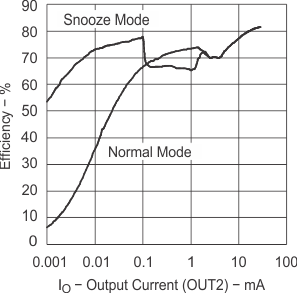SLAA398A September 2008 – August 2018 MSP430F4794 , MSP430F4794
2 DC/DC Converter Basics – PIN vs POUT
It is important to understand the relationship between power in, power out, and efficiency when selecting a converter. For an ideal physical system, the power in is equal to the power out. For the system overview depicted in Figure 1, this can be expressed as:
VBatt × IBatt = VCC × ICC
For example, if the battery voltage VBatt = 1.3 V, the MSP430 current ICC = 10 µA, and the MSP430 voltage VCC = 3.3 V, then, ideally, from the equation above, solving for IBatt yields:
IBatt = (VCC × ICC) / VBatt = 25 µA
This means that in order for an ideal dc\dc converter to supply 10 µA at 3.3 V to the MSP430, the battery would need to supply 25 µA at 1.3 V to the dc/dc converter. Ideal implies 100% efficiency but, of course, no real system is 100% efficient. Sources of inefficiency include power dissipation in the form of heat generation, switching losses, and quiescent current of the dc/dc converter itself. The graph in Figure 2 (taken from the TPS60313 datasheet) shows that when VIN = 1.3 V and VOUT = 3.3 V, the device is approximately 75% efficient when supplying an output current of 10 µA.
 Figure 2. TPS60313 Efficiency vs Output Current (VIN = 1.3 V, VOUT = 3.3 V)
Figure 2. TPS60313 Efficiency vs Output Current (VIN = 1.3 V, VOUT = 3.3 V) If we reconsider the equation PIN = POUT taking into account the efficiency of the dc/dc converter:
VBatt × IBatt = (1 / eff) × VCC × ICC
Then solving for IBatt:
IBatt = (1 / eff) × ((VCC × ICC) / VBatt) = 34 µA
Using the same values for VBatt, ICC, and VCC, IBatt is found to be 34 µA. This means that to provide 10 µA at 3.3 V to the MSP430, the battery must supply a total of 34 µA at 1.3 V to the dc\dc converter.